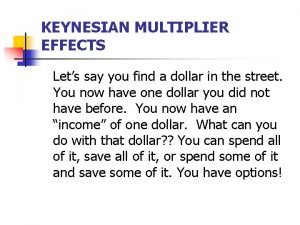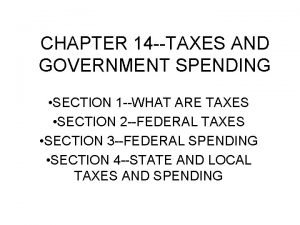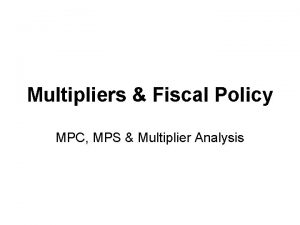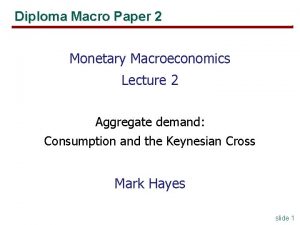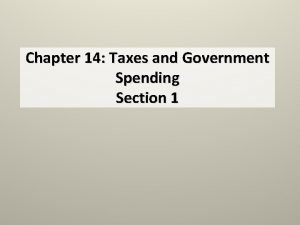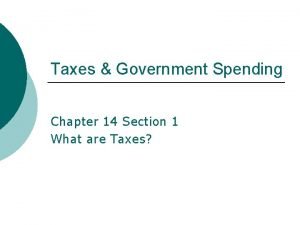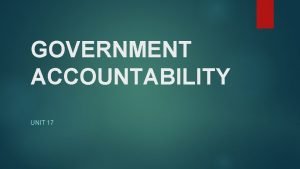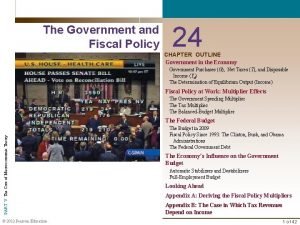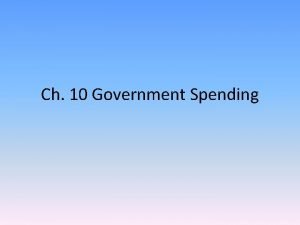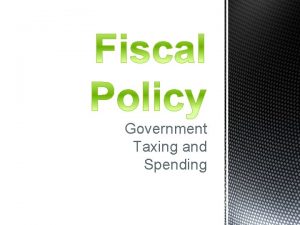Government Spending Ugh 1999 Government spending at all















- Slides: 15

Government Spending (Ugh!) 1999 Government spending at all levels: $2. 7 Trillion in 1999 --$10, 000 for each American v Government spending increased because of 3 events: The Great Depression, World War II, and LBJ’s Great Society v Governments buy everything from F-22 s to toilet paper for government buildings v Government spending creates competition within the private sector. EX: Lockheed “Skunk Works” F-117 v The National government gives money to local and regional governments to spend. See next slide. v

Cooperative Federalism Ways of Distributing $ to states: v Grants-in-Aid: grants of federal mone to cities (land-grant colleges too)…allows Congress to become enmeshed in public ed. And mental health v Block grants—fewer strings. EX: TANF v Revenue Sharing—no strings, done away with in 1986 by Reagan v Federal Agency Aid--FBI aid, other agency aid, FEMA, Census Bureau v

Establishing the Federal Budget “The President proposes, and Congress disposes” v v v The government’s fiscal year is Oct. 1 - Sept. 30. 1 st step: President confers with his advisors and drafts a budget to submit to Congress Second step: Congress accepts, rejects, or modifies. House sets budget targets and bills are referred to committees and subcommittees. Full house must vote, and this process must be completed by September 15. Process is repeated in the Senate. President may approve or veto the budget Different political parties distribute discretionary funds VERY differently. Republicans—Military spending Democrats--Welfare Now, let’s look at the results….

Mandatory and Discretionary Spending Federal Spending v v Mandatory spending refers to money that lawmakers are required by law to spend on certain programs or to use for interest payments on the national debt. Includes Social Security, Income Security, Medicare, Debt Interest, Veterans benefits 2% 15% 1% 2. 5% 16% 3% 23% 8% 12% 14% Defense Health Medicare Discretionary spending is Science, space and technology Income security spending about which Energy, natural Social Security government planners can resources, &environment Veteran’s benefits make choices. VERY small!! Agriculture Administration of Justice (Education, Employment, Other Transportation Social Services, Net interest Education Transportation, Justice, Note: Because of rounding, totals may be less or greater than 100%. Source: Statistical Abstract of the United States Environment 1% 1% 0. 7% 2%

Entitlements An entitlement program is a social welfare program that people are “entitled” to if they meet certain eligibility requirements. Social Security – Social Security is the largest category of government spending. Medicare – Medicare pays for certain health benefits for people over 65 or people who have certain disabilities and diseases. Medicaid – Medicaid benefits low-income families, some people with disabilities, and elderly people in nursing homes. Medicaid costs are shared by the federal and state governments.

Discretionary Spending v v v Defense Spending on defense accounts for about half of the federal government’s discretionary spending. Defense spending pays military personnel salaries, buys military equipment, and covers operating costs of military bases. Other Discretionary Spending Other discretionary spending categories include: education training environmental cleanup national parks and monuments scientific research land management farm subsidies foreign aid

Section Review—Federal Gov’t Spending 1. All of the following are examples of mandatory spending except (a) defense spending. (b) Medicare. (c) Social Security. (d) Medicaid. 2. An entitlement program is (a) a program to provide benefits paid to everyone. (b) a program to provide benefits paid to government employees only. (c) a program to provide benefits to people who meet certain requirements. (d) a program to provide benefits to illegal aliens.

State Government Spending State governments work pretty much the same way v Some states, however, have a balanced budget amendment. Michigan does. Why can a balanced budget amendment be both good and bad? v Local governments empower residents (Mayor, County Executives, etc. ) to approve the budget v

State/Local Government Expenditures v v v 805 of state spending goes to public welfare, insurance trust funds, higher education, highways, hospitals, etc. Is higher education an appropriate expense for the State of Michigan? The other 20% is spent on corrections, health, natural resources, and utilities Michigan spends slightly more on highways because of freeze-thaw cycle Michigan is a net donor state when it comes to highways—who’s to blame? State governments spend 2/3 of their money on schools, public utilities, hospitals, police and fire protection, interest on debt. 1/3 is left for housing and community development and parks and recreation

The National Debt The national debt is the total amount of money the federal government owes. The national debt is owed to anyone who holds U. S. Savings Bonds or Treasury bills, bonds, or notes. The Difference Between Deficit and Debt v The deficit is amount the government owes for one fiscal year. The national debt is the total amount that the government owes. Measuring the National Debt v In dollar terms, the debt is extremely large: $5 trillion at the end of the twentieth century. Economists often measure the debt as a percent of GDP.

How big is the National Debt? v About $9 Trillion, but the government owes $2 Trillion to itself, so throw that out v It’s about three weeks of income for everyone in the United States

Is the Debt a Problem? Problems of a National Debt v To cover deficit spending the government sells bonds. Every dollar spent on a government bond is one fewer dollar that is available for businesses to borrow and invest. This encroachment on investment in the private sector is known as the crowding-out effect. v The larger the national debt, the more interest the government owes to bondholders. Dollars spent paying interest on the debt cannot be spent on anything else, such as defense, education, or health care. Other Views of a National Debt v Keynesian economists argue that if government borrowing and spending help the economy achieve its full productive

How Gov’t Debt is Different from Private Debt v We owe most of the federal debt to ourselves v No repayment deadline v Private debt means someone gives up purchasing power, but when the federal government repays a debt, funds transfer to others who get purchasing power

Debt and Deficit Reduction Plans v v v Legislative Solutions In reaction to budget deficits during the 1980 s, Congress passed the Gramm-Rudman laws which would have automatically cut spending across-the-board if spending increased too much. They were declared unconstitutional in the early 1990 s. The Budget Enforcement Act required that Congress must “pay as it goes” by cutting spending in one area when spending is raised in another. Line-Item Veto (shot down ’ 98) v Constitutional Solutions In 1995 Congress came close to passing a Constitutional amendment requiring balanced budgets. v Proponents of such a measure argue that a balanced budget is necessary to make the government more disciplined about spending. v Opponents of the measure argue that it is not flexible enough to deal with rapid changes in the economy.

Review—Debt and Deficits 1. A balanced budget is (a) a budget in which expenditures equal revenues. (b) a budget in which expenditures do not equal revenues. (c) a budget in which the government spends money. (d) a budget in which revenues equal taxes. 2. Which of the following are problems associated with a national debt? (a) increased spending on defense and education (b) the crowding-out effect and interest payments on the debt (c) interest payments on the debt and too much individual investment (d) increased individual investment and decreased government spending
 Mpc econ formula
Mpc econ formula Chapter 14: taxes and government spending section 1
Chapter 14: taxes and government spending section 1 How to calculate multiplier
How to calculate multiplier Marginal propensity to consume graph
Marginal propensity to consume graph Government spending multiplier formula
Government spending multiplier formula Government spending multiplier
Government spending multiplier What is government expenditure multiplier
What is government expenditure multiplier Chapter 14 taxes and government spending
Chapter 14 taxes and government spending Chapter 14 taxes and government spending
Chapter 14 taxes and government spending Government departments are accountable their spending
Government departments are accountable their spending 24 chapter outline
24 chapter outline Name all the lines name all the segments name all the rays
Name all the lines name all the segments name all the rays Resolución 4083 de 1999
Resolución 4083 de 1999 Erf meaning in education
Erf meaning in education Fema provisions
Fema provisions Copyright 1999
Copyright 1999
